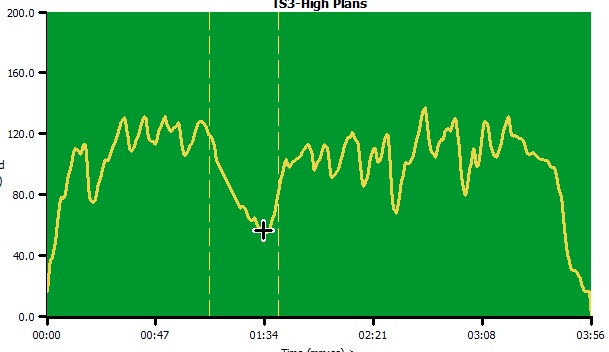PAVAS RTZ
RTZ stands for
Reduced Time Zone. These are sections of a Targa stage where the
vehicle is required to spend a given time while greater than a
minimum speed. The concept is to have a virtual chicane to restrict
the vehicle's speed.
The
Specifications
The typical
parameters fo a RTZ are a distance of 400 meters and with a time
duration of 20 seconds. Hence, to cross the RTZ in an optimum way,
the average speed required is 20 meters/sec or 72 kph. A warning sign
is located 200 meters from the start of the RTZ. A second sign
indicates the start of the RTZ and a third sign shows the end
location. If the time in the RTZ is less than 20 seconds or speed
falls below the minimum speed time penalties are incurred.
The Method
The
best method to cross an RTZ, based on loosing the minimum time, is to
approach it as fast as possible and then brake hard so that the
average speed is 72 kph; maintain that speed until the end of the
RTZ. This is a difficult task but by adhering to it, time penalizes
are not incurred. Other rally monitoring instrumentation, if fitted,
provides a countdown time showing the time remaining in the RTZ.
One problem
with this technique is that it puts a great load on the braking
system and since the energy dissipated is proportional to the square
of the speed, to converse the brakes, sensible to slow down before
entering an RTZ.
The Setup
PAVAS provides
a function to monitor operations in an RTZ. The first problem is to
determine the start of the RTZ. This is achieved by pressing the Down
in the Speed Alarms program. The is quite awkward and a separate
optional activation button can be located on the gear stick. This
designed to allow the driver, rather than the navigator, to initiate
the RTZ procedure. This button is housed in a custom clamp which is
tailored to the individual gear stick diameter.
The Method
Once the RTZ
has been entered, PAVAS provides a beep tone to advise the driver
that the RTZ calculations have commenced. PAVAS then calculates the
instantaneous average speed from the distance and time taken. PAVAS
uses the Null Guidance technique
to advise the driver, so the initial tone is a high frequency,
telling the driver to slow down. As he approaches within 10 kph of
the required average speed, the tone changes to a series of beeps
where the duration indicates how close the vehicle is to the average
speed. Once the average speed is reached, the tone stops. If the
vehicle falls below the average speed, a new tone sequence is
generated with low frequency tone. If the vehicle reaches the minimum
speed, a lower frequency tone is commenced which approximates a
growl. The tones are designed to be easily distinguishable.
Once the
vehicle is within five seconds on the end of the RTZ duration, PAVAS
emits count down beeps at one per second. The allows the driver to
judge when the time when he reaches the RTZ end sign. The RTZ mode
ends after 20 seconds and PAVAS reverts to the Speed Alarms mode.
Except for a Reset, there is no other way to terminate the RTZ
function. The RTZ procedure is designed to minimize input from the
crew.

The
figure above shows actual data from a rally stage. The RTZ speed
profile is shown between the between the dashed lines. The vehicle
enters the RTZ zone and brakes hard. The little ripples to the left
of the cursor are the gear changes. The average speed eventually
falls below 72 kph and then the vehicle accelerates while leaving the
RTZ.
2022-06-11
